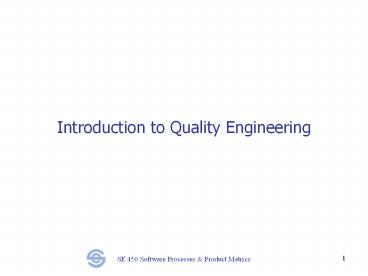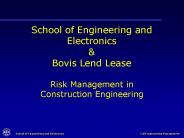Introduction to Quality Engineering - PowerPoint PPT Presentation
Title:
Introduction to Quality Engineering
Description:
Introduction to Quality Engineering Quality: Two Views Conformance to requirements (absence of defects). Narrow definition (sometimes referred to as q). – PowerPoint PPT presentation
Number of Views:234
Avg rating:3.0/5.0
Title: Introduction to Quality Engineering
1
Introduction to Quality Engineering
2
Quality Two Views
- Conformance to requirements (absence of defects).
- Narrow definition (sometimes referred to as q).
- Fitness for use (relative to needs).
- Broader definition (referred to as Q).
- Relative to actual needs, not just written
requirements. - Includes other attributes (product quality,
project business objectives, organizational
objectives).
3
Quality Engineering
- Optimize quality (not maximize)
- Preferred tradeoff among multiple objectives
- E.g. Achieve desired quality levels within cost
bounds - Aim is to design systems and systematic
approaches that continually work towards this
optimum.
4
Limitations of Quality Engineering
- Quality frameworks define what to do and how to
do it, and measure the outcomes. - They can identify and eliminate problems.
- But their effectiveness depends on the people who
do the activities involved. - Frameworks cannot deliver excellence. Only people
can deliver excellence.
5
Processes
- (Systematic) steps for accomplishing a task
- Structured approach to getting things done.
- The best process for a task is that which
accomplishes the task most effectively i.e.
optimizes across task objectives.
6
More Process vs. Best Process
- Processes maximize probability of successful task
accomplishment, i.e. prevent problems. - More process (i.e. more formality) improves
probability of success, but runs counter to other
objectives (cost, flexibility). - Best process optimizes across task objectives,
hence more process is not always good.
7
Process Design
- Designing good processes requires
- Understanding the various task objectives.
- Understanding the impact of the steps involved
(process design decisions) on all the different
objectives. - Creatively identifying different possible
approaches (designs) and picking the best. - A typical engineering design problem!
8
Limitations of Process
- Processes are designed to prevent problems
(reduce variance of output). - Process is not free there is a cost in time and
effort, as well as in flexibility. - Processes incorporate assumptions about the
nature of the task and about the objectives but
every situation is a little different. The more
the difference, the less effective the process. - Process customization (tailoring) is not free!
9
Metrics
- The purpose of metrics is to provide evaluation
and feedback (Try walking to the door with your
eyes closed). - They can provide an objective view to
complement the subjective view of the people
doing the job. - When skillfully used, metrics can reveal
longer-term trends that are harder to spot
otherwise (filter out random variation).
10
Metrics Interpretation
- Moral of the story Metrics tell us something,
but to make sure that the numbers dont mislead
us, we need to do a lot of additional work
behind the scenes - Doing this requires
- Metrics understanding
- Domain understanding
- Familiarity with the specifics of the situation
11
Metrics Interpretation
- Any chart should be accompanied by comments that
point out what lies behind the numbers. - This is the real value added by the quality
engineer!
12
Famous Lines About Metrics
- There are three kinds of lies lies, damned lies
and statistics - What statistics reveal is interesting, but what
they conceal is vital
13
Another Famous Line
- If you cant measure it, you cant control it
- (The idea is that measurement helps to close the
feedback loop, which is necessary)
- Flip side
- If you manage purely by the numbers, all you
manage is the numbers - (Objectives that are not measured will not be
met, and some of them may be the most important
ones. And as we have seen, numbers dont reveal
the entire truth)
- To ponder Is the goal to control the outcomes,
or to facilitate achievement of better outcomes?
14
Conclusion
- Quality engineering is about effective ways to
achieve project objectives. - Processes and metrics are enablers to achieve
these objectives. - Defining good processes and selecting good
metrics is a challenging design problem. - Metrics interpretation is critical. If not done
well, all work collecting data etc. is useless.





























![[CS-225: Software Engineering] PowerPoint PPT Presentation](https://s3.amazonaws.com/images.powershow.com/7552154.th0.jpg?_=20160119103)

